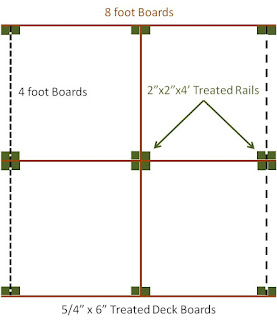My bin, which I have been using since 2004, is a four bin setup I made out of used treated deck boards. I got the boards for free after someone disassembled an old deck. The good 8' boards were used whole and damaged boards were cut to four foot length.
 |
| Side View |
So now that you have a place and a bin of some sort you need to collect the materials you want to compost. In the fall and winter the bulk of your material is probably going to be leaves. I usually use my lawn tractor to windrow the leaves and partially chop them up. If you keep cutting in one direction the leaves and some grass will blow into one long row. Then I rake them up and run them through my shredder but if you don't have a shredder you can just run over them a few more times with the mower. The finer the material the faster it decomposes into compost.
The only way to get a hot compost in the colder months is to add manure or some other high nitrogen material and keep it well aerated. Horse, cow, or poultry manure are good for making cold weather compost. Mix that in with the leaves, wood chips, grass, and kitchen wastes. It is always a good idea to sprinkle in finished compost or screened soil to add the micro-organisms needed to start the composting process. Cover the bin with clear plastic to create a mini-greenhouse and create more heat during the day and keep it warm at night. You'll need to turn the pile every 2-3 days to keep it well oxygenated.
Turning the pile. What does that mean? Simply put it means re-mixing the materials and aerating it by "fluffing" up the material. I usually use a pitchfork to take everything out of one bin and toss it into the next bin while twisting the pitchfork side to side. This breaks up the clumps and get lots of airspace into the pile. Usually, after turning a fairly fresh pile, the temperature will spike in a couple hours as the biological activity increases. With the proper mix of materials and aeration your pile should get to 140-160 degrees warm on the inside. Of course the outside layer will not be as warm but that is why you turn the pile every couple days. This brings the outer layers to the inside of the pile and feeds the micro-organisms fresh material.
During the party season there seems to always be left over soda, beer, and sweets. These are all good to add to a compost pile. The sugars feed the micro-organisms and give them a quick burst of energy.
Unfortunately, if you live in a cold weather area your pile will eventually cool down and freeze but in the spring you'll have a jump start on an early batch of compost.
If it is already too cold to compost in your area you can use this time to stockpile materials. Pile all your leaves out of the way and cover with a tarp or plastic. The wire fence surrounds are ideal for storing materials for later use.
During the winter you want to cover all your compost materials, especially finished compost, so the nutrients aren't leached out by rain water. My four-bin system has one covered bin reserved for storing finished compost. Even finished compost can break down further during the "curing" process. My curing bin is usually filled with earthworms and they contribute more nutrients through their digestive cycle.
So what if you have neither the time nor the inclination to work on a hot compost system? Well, you can still produce good compost but it just takes a longer time. We'll look at that next.

No comments:
Post a Comment